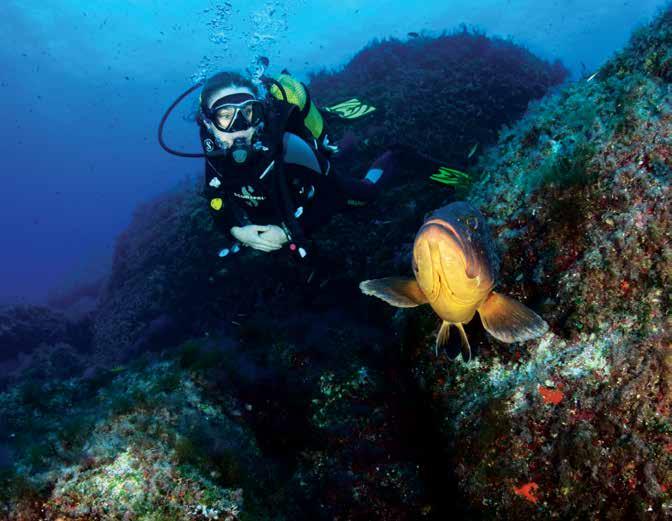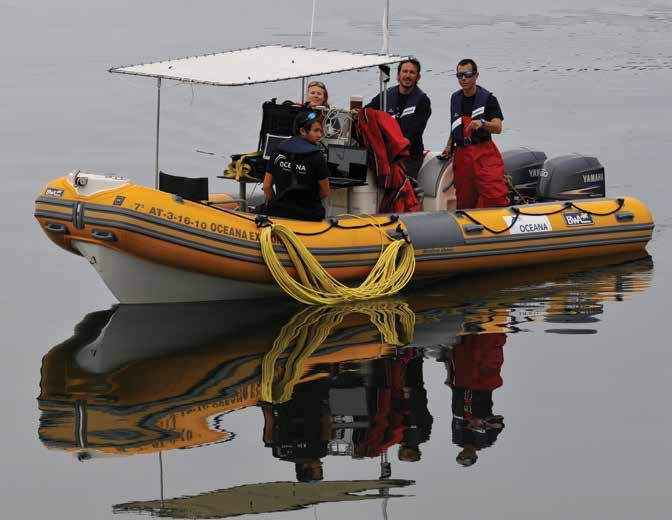
4 minute read
On the Water
OCEANA’S AT-SEA CAMPAIGNS AND EXPEDITIONS HELP CATALYZE POLICY ACTION
BALEARIC ISLANDS
Exploring deep-ocean ridges
Clustered off the east coast of the Iberian Peninsula, the Balearic Islands host beaches popular with European tourists and vast expanses of unexplored and biologicallyrich ocean. In August 2013, Oceana took its catamaran research vessel, the Ranger, to document the diverse and varied sea life inhabiting the Emile Baudot escarpment.
The Emile Baudot is a large, rocky wall running from Ibiza to Menorca, spanning more than 180 miles and reaching depths of up to 2,000 meters below the surface. The Ranger’s crew explored the ridge for 10 days with the aid of a remote operated vehicle (ROV), gathering the first underwater footage of the escarpment.
Near the ocean’s surface they found dolphins, manta rays, and swordfish. As the ROV descended, the researchers saw large, grey groupers and long-spined sea urchins tucked in caves, and fields of brachiopods and crinoids blanketing the slopes of the escarpment. But the ROV also uncovered evidence that human garbage is infiltrating these magnificent deep-sea areas, including plastic bags, cans, and fishing gear as much as 700 meters below the surface.
© OCEANA | Xavier Mas
Though the Emile Baudot escarpment lies just beyond the southern tip of Spain’s famed Cabrera National Park, it is completely unprotected from pollution and overfishing. The footage and data collected on the expedition will strengthen Oceana’s campaign to expand the national park to include the escarpment.
BALTIC SEA
Assessing the health of shallow Baltic waters
Ocean expeditions don’t usually involve a road trip. But when the 2013 Baltic expedition team kicked off their journey, they didn’t do it from the deck of a boat. In a first for Oceana, the team embarked on a 32-day amphibious research expedition, driving 7,000 kilometers through eight countries to document the health of the Baltic Sea. The expedition confirmed earlier reports that the Baltic’s shallow habitats are suffering from pollution and overfishing.
The Baltic has many shallow, hard-to-navigate areas that are not accessible to large boats, so the 2013 expedition used small, trailered boats. Oceana’s researchers piloted 50 ROV dives from an inflatable boat, pebble-covered beaches, and even a public pier in Poland. The crew also donned scuba gear to conduct 20 dives from the coast. High-definition cameras recorded hours of video footage and snapped more than 6,000 photographs during the six-week expedition.
The expedition’s findings confirmed that the sea’s shallow archipelagos are suffering from pollution and overfishing, much like the deeper areas of the sea, which is causing filamentous algae blooms that suffocate other algae and plants, like sea grass.
Oceana presented data from this expedition, and others in 2011 and 2012, in its proposal for the creation of 12 new MPAs and new management measures to improve the effectiveness of existing protected areas. Data and photos from this expedition allowed Oceana to expand current MPA proposals, including adding a thirteenth proposed protected area. If implemented, Oceana’s proposal would nearly double the total protected areas in the Baltic, protecting more than 20 percent of this inland sea. To safeguard the region’s biodiversity and fishery productivity, Oceana’s ultimate goal is to conserve a full 30 percent of Baltic.
OREGON COAST
Documenting seafloor fish habitat
Oceana’s Pacific expedition’s eight-man crew set sail on the Miss Linda out of Newport, Oregon in August, embarking on a week-long scientific expedition to explore rare seafloor habitats off the coast of central and northern Oregon. The researchers collected data and footage validating Oceana’s proposal for increasing essential fish habitat protections in the Pacific.
The team completed 25 dives with a ROV in seven days, reaching as far as 1,200 feet below the surface. Using highdefinition cameras mounted on the ROV, the team filmed fields of vibrant cold-water corals, sea pens, sea whips, and decades-old glass sponges dotted with rockfish. But the ROV also revealed deserts devoid of any living structures, possibly the result of decades of bottom trawling.

Fish of all species need protected areas where they can find food and shelter, spawn, and establish nursery habitat for their offspring to grow. Oceana’s proposal would protect an additional 20,000 square miles of key habitats on the continental shelf and slope, like the ones explored during the expedition, and an additional 120,000 square miles of deepsea habitats.
DESVENTURADAS ISLANDS
Exploring remote Chilean islands
In February, Oceana and National Geographic launched a joint expedition to the Desventuradas, two small islands more than 500 miles off the coast of Chile. Staffed by a team of scientists equipped with cutting-edge technology, the expedition was the first to explore one of the last pristine marine environments left in the Pacific Ocean.
Outfitted with a state-of-the-art three person submarine, capable of reaching depths of almost 1,500 feet with a 360-degree view, the team of explorers completed more than 280 dives and shot more than 80 hours of video. Their footage showed undulating kelp forests, brightly colored corals, and massive 15-pound lobsters. Oceana presented data gathered on the expedition in a comprehensive scientific report on the marine life and habitat of the Desventuradas, which became the basis of a proposal to create a large marine reserve.
© OCEANA | Carlos Minguell LEFT PAGE: Oceana senior adviser Alexandra Cousteau swims with a grouper in National Park of Cabrera (Balearic Islands), during the campaign to expand ten times its extension. RIGHT PAGE: Oceana Baltic team deploying the ROV from a rigid inflatable boat during the 2013 coastal expedition.









